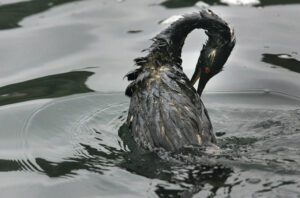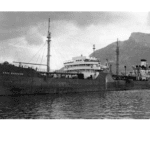The wreck of the Esso Wheeling
The wreck of the Esso Wheeling in 1948 caused the first of a series of oil spills that have threatened local seabirds. The oil slick drifted toward Dyer Island and killed about one-third of the African penguin colony that lived there

: “Soiled penguins died on the beaches or stayed on the islands and died of hunger. Nesting birds were affected and chicks also died.
From 1968 when the Suez Canal was closed, oil tankers chose to negotiate the Cape sea route. The tankers were not designed to cope with the waters around the Cape of all storms.
In 1968 the Esso Essen was sailing within the prescribed 16 km safety zone just 5 km from shore. The ship was illegally using the route around the Cape. It struck an object and 4000 tonnes of oil were spilled. This killed thousands of sea birds. After the Esso Essen incident, the Southern African National Foundation for the Conservation of Coastal Birds (SANCCOB ) was established. Suitable facilities have been developed to deal with oiled seabirds, particularly penguins. Since the Esso Essen disaster, there have been 5 other oil spills that have affected more than 1000 penguins. By far the worst incident on the South African coast was the sinking of the iApolla Sea near Dassen Island. This resulted in more than 10’000 penguins getting covered in oil. The most recent oil spill that affected more than 1000 birds was in 1995 off Danger Point. Still, each year, about 1000 oiled penguins are brought to SANCCOB due to oil spillages.


